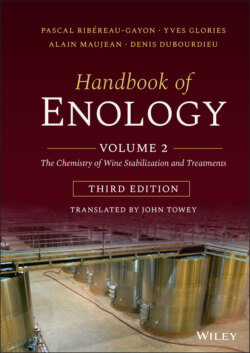Читать книгу Handbook of Enology, Volume 2 - Pascal Ribéreau-Gayon - Страница 51
2.2.2 Higher Alcohols of Fermentation Origin
ОглавлениеAlcohols with more than two carbon atoms are known as higher alcohols or fusel oil (Table 2.1). Several of these are produced during fermentation. For reasons of simplicity, they are generally referred to collectively, reaching total concentrations on the order of 150–550 mg/l in wine (Ribéreau‐Gayon et al., 1982; Jackson, 1994). These alcohols and their esters have intense odors that play a role in wine aromas. The main higher alcohols of fermentation origin are isobutyl alcohol (2‐methyl‐1‐propanol) and amyl alcohols (a mixture of 2‐methyl‐1‐butanol and 3‐methyl‐1‐butanol). At low concentrations (less than 300 mg/l), they contribute to a wine's aroma complexity. At higher levels, their odors mask the wine's aroma finesse. Acetates of these alcohols, especially isoamyl acetate, have a banana odor that may play a positive role in the aroma of some young red wines (nouveau‐type).
Higher alcohols are formed by yeast, either directly from sugars or from grape amino acids by the Ehrlich reaction (Figure 2.4). This reaction is caused by the activity of a FAD+ dehydrogenase, which oxidizes amino acids into imino acids. These are hydrolyzed into α‐ketoacids and then subjected to the action of a decarboxylase with thiamine pyrophosphate (TPP) coenzymes. Via this pathway, leucine produces isoamyl alcohol, and isoleucine results in optically active amyl alcohol with an asymmetrical carbon. The higher alcohol content of fermentation origin in wine varies according to fermentation conditions, especially yeast strain. In general, factors that increase the fermentation rate (yeast biomass, oxygenation, high temperature, and the presence of matter in suspension) also increase the formation of higher alcohols.
TABLE 2.1 Simple Alcohols Originating from Grapes and Yeast (Ribéreau‐Gayon et al., 1982)
| Formula | Name | Boilingpoint (°C) | Concentration(g/l) | Comments oralternative name |
|---|---|---|---|---|
| H−CH2OH | Methanol | 65 | 0.1 | Produced by hydrolysisof pectins, not fermentation |
| CH 3−CH2−OH | Ethanol | 78 | 100 | |
| CH 3−CH2−CH2OH | 1‐Propanol | 97 | 0.03 | |
| CH 3−CHOH−CH3 | 2‐Propanol | 82 | Traces | Isopropyl alcohol |
| CH 3−CH2−CH2−CH2OH | 1‐Butanol | 117 | Traces | |
| 2‐Methyl‐1‐propanol | 107 | 0.1 | Isobutyl alcohol | |
| 2‐Methyl‐2‐propanol | 82 | ? | ||
| CH 3−CH2−CHOH−CH3 | 2‐Butanol | 99 | Traces | |
| CH 3− CHOH−CHOH−CH3 | 2,3‐Butanediol | 183 | 1 | |
| CH 3−CH2−CH2−CH2−CH2OH | 1‐Pentanol | 137 | Traces | |
| CH 3−CH2−CH2−CHOH−CH3 | 2‐Pentanol | 119 | Traces | |
| CH 3−CH2−CHOH−CH2−CH3 | 3‐Pentanol | 115 | ? | |
| 3‐Methyl‐1‐butanol | 131 | 0.2 | Isoamyl alcohol | |
| 2‐Methyl‐1‐butanol | 129 | 0.05 | Active amyl alcohol | |
| 3‐Methyl‐2‐butanol | 112 | ? | ||
| cis‐3‐Hexen‐1‐ol | 156 | Present only in grapes withherbaceous odors | ||
| CH3−(CH2)4−CH2OH | 1‐Hexanol | 158 | 0.01 | |
| CH3−(CH2)3−CHOH−CH3 | 2‐Hexanol | 138 | ? | |
| CH3−(CH2)5−CH2OH | 1‐Heptanol | 177 | Traces | |
| CH 3−(CH2)4−CHOH−CH3 | 2‐Heptanol | 160 | ? | |
| CH 3−(CH2)6−CH2OH | 1‐Octanol | 194 | ? | |
| CH 3−(CH2)5−CHOH−CH3 | 2‐Octanol | 180 | ? | |
| CH 3−(CH2)7−CH2OH | 1‐Nonanol | 212 | ? | |
| CH 3−(CH2)6−CHOH−CH3 | 2‐Nonanol | ? | ||
| CH 3−(CH2)8−CH2OH | 1‐Decanol | 229 | ? | |
| Φ−CH2−CH2OH | 2‐Phenylethanol | 219 | 0.05 | Fermentation alcohol(rose odor) |
| OH−Φ−CH2−CH2OH | Tyrosol | |||
| CH 3−(CH2)4−CHOH−CH=CH2 | 1‐Octen‐3‐ol | Mushroom odor |
Φ, benzene ring.
FIGURE 2.4 Biosynthesis of higher alcohols, according to Ehrlich.
Higher alcohols are found in brandies after distilling and contribute to their specific characters. Distillation techniques have a major impact on their overall concentration.
